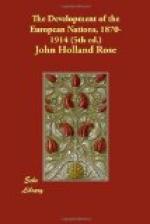[Footnote 370: History of the Campaign in Egypt (War Office), by Col. J.F. Maurice, pp. 62-65.]
The final action took place on September 13, at Tel-el-Kebir. There Arabi had thrown up a double line of earthworks of some strength, covering about four miles, and lay with a force that has been estimated at 20,000 to 25,000 regulars and 7000 irregulars. Had the assailants marched across the desert and attacked these works by day, they must have sustained heavy losses. Sir Garnet therefore determined to try the effect of a surprise at dawn, and moved his men forward after sunset of the 12th until they came within striking distance of the works. After a short rest they resumed their advance shortly before the time when the first streaks of dawn would appear on the eastern sky. At about 500 yards from the works, the advance was dimly silhouetted against the paling orient. Shortly before five o’clock, an Egyptian rifle rang out a sharp warning, and forthwith the entrenchments spurted forth smoke and flame. At once the British answered by a cheer and a rush over the intervening ground, each regiment eager to be the first to ply the bayonet. The Highlanders, under the command of General Graham, were leading on the left, and therefore won in this race for glory; but on all sides the invaders poured almost simultaneously over the works. For several minutes there was sharp fighting on the parapet; but the British were not to be denied, and drove before them the defenders as a kind of living screen against the fire that came from the second entrenchments; these they carried also, and thrust the whole mass out into the desert[371]. There hundreds of them fell under the sabres of the British cavalry which swept down from the northern end of the lines; but the pursuit was neither prolonged nor sanguinary. Sir Garnet Wolseley was satisfied with the feat of dissolving Arabi’s army into an armed or unarmed rabble by a single sharp blow, and now kept horses and men for further eventualities.
[Footnote 371: Life, Letters, and Diaries of General Sir Gerald Graham (1901). J.F. Maurice, op. cit. pp. 84-95.]
By one of those flashes of intuition that mark the born leader of men, the British commander perceived that the whole war might be ended if a force of cavalry pushed on to Cairo and demanded the surrender of its citadel at the moment when the news of the disaster at Tel-el-Kebir unmanned its defenders. The conception must rank as one of the most daring recorded in the annals of war. In the ancient capital of Egypt there were more than 300,000 Moslems, lately aroused to dangerous heights of fanaticism by the proclamation of a “holy war” against infidels. Its great citadel, towering some 250 feet above the city, might seem to bid defiance to all the horsemen of the British army. Finally, Arabi had repaired thither in order to inspire vigour into a garrison numbering some 10,000 men. Nevertheless, Wolseley counted on the moral effect of his victory to level the ramparts of the citadel and to abase the mushroom growth of Arabi’s pride.




